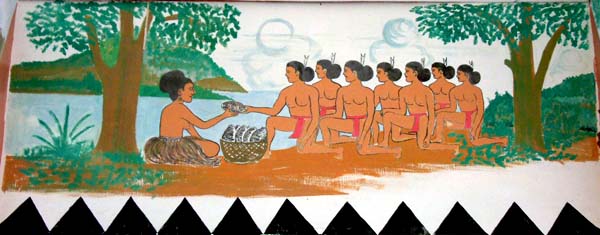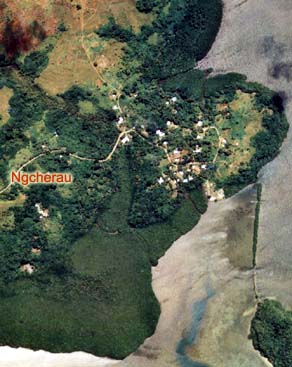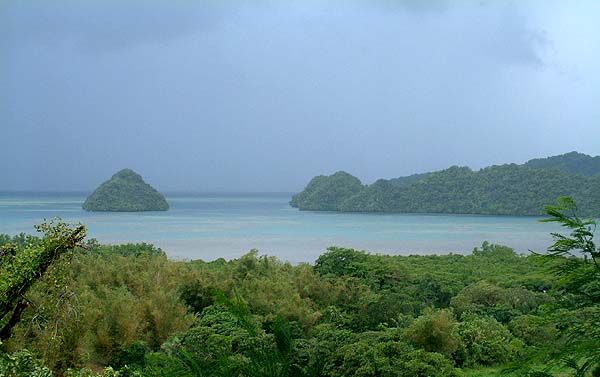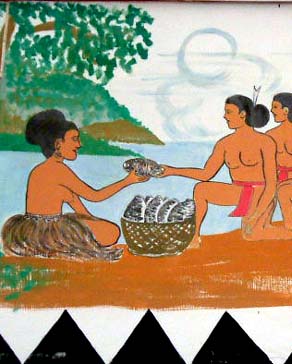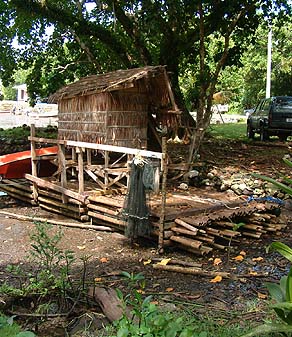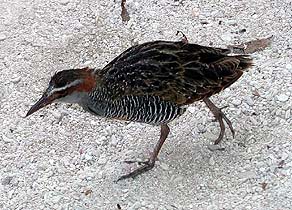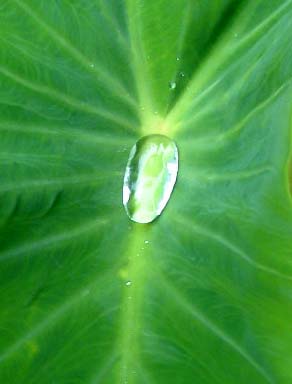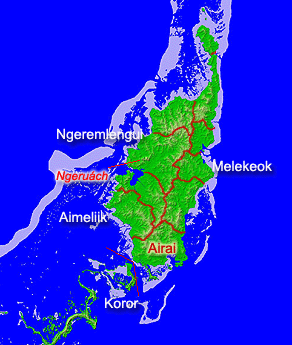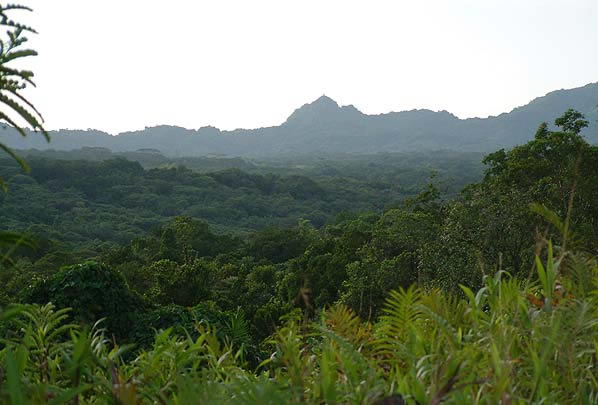 |
 |
 |
 |
||||
|
|
|
|
|
|
|
|
|
|
|
|||||||
|
|
|
|
Dirrabkau (Milad) and the seven tekiimeláb.
|
|
“There's an ancient Palau" Johnson explains, "from Chuab, a lady who fell down across the island and her body became Palau. That's the old Palau." The story of Chuab is often told to visitors in Palau as explaining the origin of the islands. But less often heard by visitors is the story of Milad. "This a new Palau, after the flood," Johnson says. "Our version of the flood story is a legend of Palau. Maybe the story of the Great Flood should be told by someone either from Koror, Ngeremlengui, or Melekeok, the three supposed children of Milad. But the old man here knows the chants, and will tell the story: The story of a woman by the name of Milad." And so Rucherudel begins the story :
|
||
|
|
||
|
"Milad came to a village up on the hills of Airai overlooking this village, known as Ngcherau, where she planted taro upside down. And while there, her daughter became a friend of another young girl there. Whenever Milad went to the taro patch, her daughter and the neighbor girl would go swim in a pond. But unfortunately, the friend had no lunch snacks, because her mother could not cultivate taro. "But Milad was some kind of a supernatural person, and had plenty of taro. So Milad told her daughter, ‘when your friend has nothing to eat, you give your share to her,’ which was done. And the friend’s mother asked Milad to help her plant her taro. But Milad started planting the taro upside down, because she was supernatural, so instead of planting the taro to get the root, she would just go and harvest the taro because they were planted in reverse. It was easier to harvest. "When the mother saw them planted upside down, she expressed frustration by saying, ‘how stupid, you cannot plant things upside down.’ So, Milad could not stand to live with her anymore, and she moved down through the village to the east side of Airai to the village of Ngchesang, to a small area known as Ngerchebukl. There she became known as Dirrabkau. Dira is a title used for women. Bkau is a tree."
|
|
|
|
"While she was there, some earthling, a Palauan, plucked out the eye of the Keeper of the Ladder to Heaven, Tembokl. So Uchelianged, a really major god— uchel is god, eanged is Heaven—sent seven tekiimeláb. Tekiimeláb are people who, in the olden days, were half-man and half-god, like angels or something. He sent seven of them—seven is a good number in Palau—and told them, ‘you go and try to find the person who plucked the eye of the Keeper of the Gate to Heaven.’ "And before they left Heaven, the Heavenly God baked semi-brown coconut, called ulechóuch. When you burn the shell it becomes black and it gives a specific aroma, supposed to appease the gods. God told these seven tekiimeláb to descend upon Angaur and walk across the Palau islands. And, if they came to a place where the baked coconut would explode, they should stop and look there."
|
|
|
|
|
"So they came from Angaur all the way to Airai, and some place in Airai they caught seven rabbit fish. Those were to be their lunch. Carrying them, they walked all the way to a place in Ngchesang, where the baked coconut exploded. So they stopped. "There they saw the old lady cooking taro, so they said politely, ‘mother,’—that's a Palauan way of showing respect, ‘mother’—‘would you please cook our seven rabbit fish for us so that we can eat them on the way back?’ But the old lady, instead of cooking them, split each taro in the middle, which were hot from the boiling water, and she put the rabbit fish in between and tied the taro together again, and put the seven of them into a basket."
|
||
|
|
||
|
"When these seven tekiimeláb came back, they said, ‘Mother, is our rabbit fish ready?’ She didn't say anything but handed over to them a basket with seven pieces of taro. So they took them, but they felt bad that this lady did not cook their rabbit fish, only gave them taro. But when they opened them they realized that this woman had put the rabbit fish between two pieces of taro, like a sandwich, and that the heat from the taro had cooked the rabbit fish. So they were very grateful. "So the Big God told them to come back and tell her that a big flood would soon come into the islands and destroy Palau. She should please consult a child that she found in the taro patch named Ngiselacheós. Ngisél means the egg. Cheós is the sun, so Ngiselacheós means ‘the egg of the sun.’ "Dirrabkau had gone to a taro patch one day and some animal, like a bird or a reptile, gave birth to an egg. So she picked it up and took it home and said, ‘when I cook my taro I will cook this egg and eat it.’ But every time she went to cook her taro she forgot about the egg, and kept forgetting it until the egg hatched by itself and there came out a baby boy. So she named the baby Ngiselacheós."
|
|
|
|
"So the seven tekiimeláb came back, being grateful for what she did for them, and told her there would be a big flood to destroy the islands. ‘So tell Ngiselacheós to go to the woods and get long vines, and you make a big raft. And you make a long anchor for the raft so when the flood comes in, you can survive.’ "But Ngiselacheós only got a short string. So when the flood came, Dirrabkau was on the raft and when the tide kept rising, the raft capsized and she drowned. And this lady Dirrabkau lived in Ngchesang at the place called Ngerechebukl—that's a place there today. But when the big bamboo raft capsized, she drowned and drifted with the currents. "She drifted until her foot caught in a crack in one of the two high peaks in Ngeremlengui known as Ngeruách. It's a volcanic peak. Oách means the leg, and since her leg caught the crack there, they called it called Ngeruách, 'Leg Peak'."
|
|
|
|
| "The seven tekiimeláb realized the tragedy about this lady whom they called ‘Mother’, who took care of them, and how her body drifted and got stuck by Ngeruách. So these seven tekiimeláb gathered together and began to look for ways to revive and resurrect their ‘Mother.’ "They began to look for the proper medicine but whenever they said, ‘maybe it's this medicine,’ a Palauan bird called terriid—a type of rail that has red on top of its head—was screaming, ‘no, no!’ "So they took a piece of wood with a sharp edge which they used to husk coconut, and hit the rail on the head so it began to bleed. That's why the rail has a red head today."
|
|
|
|
"The seven tekiimeláb went back to Heaven and the Heavenly God, Uchelianged, told them, ‘I'm going to give you special water.’ He made special water. And placed that water on the leaf of taro. The taro leaf is almost waterproof—if you put water on it, it rolls around on it. And he told them, ‘You carry this special water, it's a living water, back to Earth and give it to this lady, the Mother, and she will come back to life. But be very careful, because if the taro leaf gets torn or gets pricked and this water falls on anything, that thing will live forever.’ "As they were descending from Heaven to Palau, they slipped and a special Palauan tree called chermall pricked the taro leaf and the divine water spilled on that tree. That is a tree which we use the bark to make ropes with and it grows all over Palau. And that's why today that tree never dies. You can cut a twig or break it and it grows. So they lose that water but this tree doesn't die. It keeps on growing."
|
"But the tekiimeláb continued and took the body of Dirrabkau to the base of Ngeruách and they nursed her somehow, because they were kind of a semi-god, semi-human, and brought her to life. "And when she came back to life, she gave birth to New Palau. The oldest son is Ngeremlengui, the place where the peak is. The second son was Melekeok, where high chief Reklai is, and the third was a daughter, Imeliik (from which Aimleiik State is named). And then the youngest child was Koror (from which Koror State is named). Those are the four children of Milad. "That's why we rank Imeliik and Melekeok so high. Ngeremlengui is the oldest, so therefore he's not prominent but respected. Koror was the youngest son of Milad, and the word Koror or Koror comes from the word sureór,‘a working person.’ Koror in Palauan means ‘to work.’ So Koror's heritage, being the youngest, was to become the most industrialized or most commercialized place in Palau."
|
|
|
|
|
|
"Dirrabkau transformed to become Milad after the flood. 'Milad' sounds almost like the word mlad, which means, ‘who died.’ She died but not quite, and gave birth to these four villages of Palau, the new generation of Palau. "There’s a chant about why Palau brought forth the new generations. Koror and Airai and Peleliu are kind of together in what are called the ‘divine wisdoms.’ The ancient wisdom of governance, how it came to Palau, falling from the sky like an arrow and hit Palau straight down. It's a kind of a mystical, philosophical chant about how Palau came to being after the flood and how God blessed Palau and how the four villages became the four corners of a new Palau. That's the story of Milad."
|
||
|
|
||
Airai sits between the two most powerful of these four ranking villages. And it is Airai's relationship to these neighbors that defines its position in Palau.
|
||
|
|
||
|
|
|
|
|
|

|
| Airai Home | Map Library | Site Map | Pacific Worlds Home |
|
|
|
|

|
|
|
|||
| Copyright 2003 Pacific Worlds & Associates • Usage Policy • Webmaster |
|||
